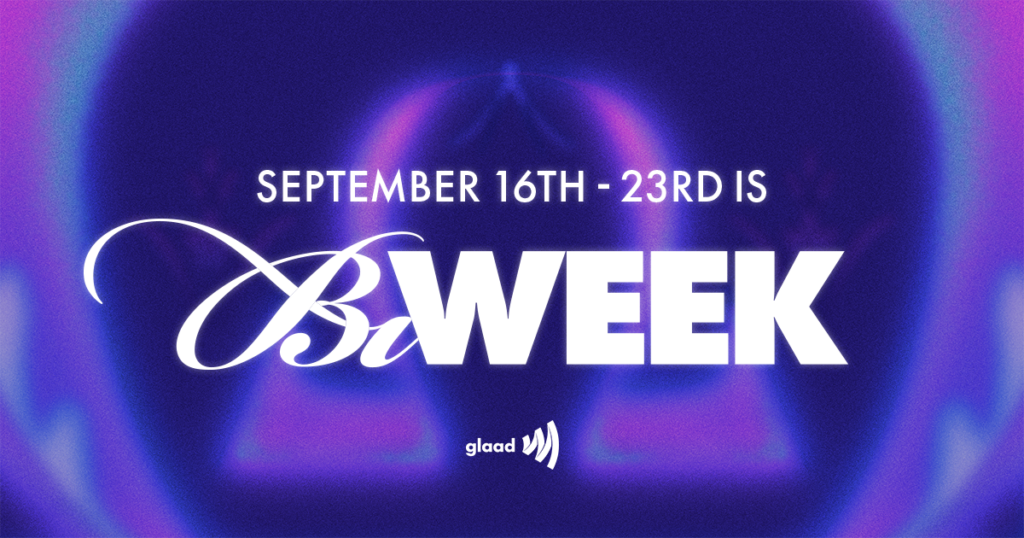GLAAD Joined Award-Winning Journalists in Panel on Bisexual+ Media Representation at 2024 NLGJA Conference Earlier This Month
Today, September 23, marks Celebrate Bisexuality Day, an annual day acknowledging the contributions and history of bisexual and bi+ people.
Although bisexual people make up the majority of the LGBTQ population (more than half at 57.3%), they are also far less likely than their gay and lesbian counterparts to come out; and bisexuals face unique forms of discrimination, including staggering rates of physical and mental health disparities. Celebrate Bisexuality Day is intended to dispel dangerous myths and stereotypes about people who are bisexual and/or people who fall under the bisexual+ umbrella of being attracted to more than one gender.

One of the most common definitions of bisexuality comes from Robyn Ochs, a leading advocate and author on bisexual issues. She describes the term as “the potential to be attracted – romantically and/or sexually – to people of more than one sex and/or gender, not necessarily at the same time, not necessarily in the same way, and not necessarily to the same degree. For me, the bi in bisexual refers to same and different gender attraction.” Another common term used to describe attraction to more than one gender is “pansexual,” which Sue Cortenas-Soto at the Trevor Project defines as “a sexual, romantic, or emotional attraction to “people of all genders, or regardless of their gender,” with the prefix “pan” comes from the Greek word for “all.” Many different identifiers exist and it’s best to use the term that someone uses to describe themselves.
According to research earlier this year, among Gen Z adults — the most out generation in history — 15% overall identify as bisexual, representing more than two-thirds of those with any LGBTQ+ identification. Furthermore, more than one in five Gen Z women identify as bisexual, as do 9% of millennial women. Combined data from 2022 and 2023 indicate that about 80% of nonbinary adults identify as LGBTQ+, with one-third being bisexual and one-third transgender.
Data collection around LGBTQ identification overall and bisexual identity specifically has improved over recent years, but it’s important to remember that these numbers are still underreported, especially for bisexual people who are less likely to disclose due to a lack of visibility and explicit community spaces, often described as “bisexual erasure.” Common misunderstandings also dissuade people from associating with the term bisexual, such as the notion that all bisexual people are attracted to one or more genders equally, that being bisexual means only binary attraction and that it excludes transgender and nonbinary people, or that bisexual people are necessarily polyamorous. There is no one way to be bisexual, and any form is valid.
GLAAD was honored earlier this month to participate in a gathering of the Association of LGBTQ Journalists (NLGJA) in Los Angeles for several days of in-person networking and informative sessions about how to maximize fair, accurate, and inclusive coverage of LGBTQ people and issues. In particular, GLAAD organized a panel on the current landscape of bisexual representation and storytelling in the media and best practices and recommendations for reporters.

The panel included Clare Mulroy, an SEO reporter at USA Today; Lauren McGaughy, an investigative reporter and editor for The Texas Newsroom; Duante Beddingfield, the arts and culture reporter for the Detroit Free Press; Nico Lang, an award-winning journalist and recent author of a new book about the lives of transgender youth; and Angela Dallara, GLAAD’s Director of Rapid Response and Campaigns. The panel members hosted a discussion about their experiences pitching bisexual stories to editors and ways to highlight bisexual people in impactful stories in front of a group of more than 30 activists and media experts.
GLAAD is committed to amplifying positive and accurate stories of bisexual people and issues every day. To learn more, refer to the section of GLAAD’s Media Reference Guide dedicated to bisexual people: https://glaad.org/reference/bisexual/.













